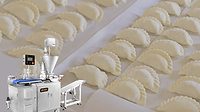Antifouling Surfaces To Reduce Biofouling In The Food Industry

Solutions to mitigate biofouling in the food industry are urgently needed. The World Health Organization (WHO) regional director for Europe has stressed that food safety is a shared responsibility. However, the complex issue of how food gets from farm to fork is a transdisciplinary issue. Therefore, a multidisciplinary approach is needed to address this issue.
A project designed to develop food contact surfaces to reduce fouling, transmission and contamination issues has been suggested to contribute in part to providing such a solution. Surfaces such as gasket materials, conveyor belts and work tables are prime locations for bacterial adhesion and subsequent development of bacterial communities embedded within a self-produced matrix of extracellular polymeric substances, called biofilms. Although food processing surfaces can be sanitized to a high degree using current sanitization protocols, a clean surface can be immediately soiled by a contaminated product and can thus cross-contaminate food products throughout the remaining processing run. Additionally, gene transfer potentiates the development of resistance to currently used biocides and disinfectants, making sanitation programs less effective. In light of this, a European project has been funded and has been running since 2021 entitled SurfSAFE—surface modification to increase microbial safety in the food industry. This project aims to develop polymeric surfaces that prevent adhesion due to an unfavorable topography or chemistry (antifouling surfaces).
SurfSAFE’s partner institutions (University of Porto, Portugal; Manchester Metropolitan University, UK; University of Copenhagen, Denmark; and University Medical Center Groningen, Netherlands) are collaborating to capitalize their experience and know-how to provide knowledge leading to a further development of non-biotoxic biomimetic polymeric surfaces that avoid bacterial adhesion. It is hoped that once applied in situ, the approach will minimize downtimes and thus provide substantial cost benefits to the industry. In addition, the consumption of partially hazardous chemicals can be decreased by reducing biofouling on surfaces and potentially cleaning and disinfection processes, thus reducing the use of water and disposal of cleaning solutions into the environment.However, several major challenges remain. It is recognized that surface properties, such as topography, chemistry and physicochemistry, affect biofilm formation and bacterial virulence, however the underlying mechanisms are poorly understood. Additionally, the deposition of an organic layer of material onto a surface, known as a conditioning film, and its effects on the bacteria-surface interactions and gene transfer among bacterial species have not been properly identified. Further, materials research often focuses on the antifouling activity of the surface in a single-species mode under ideal conditions and often disregarding bacterial species interactions. The food processing environment is extremely complex and surfaces are colonized by a dynamic consortium of microorganisms and organic material that interact with each other.
We aim to validate the antiadhesive efficacy of developed surfaces under conditions similar to its intended application, e.g. food processing and packaging industries. Both surfaces and biofilms will be analyzed using state-of-the-art imaging techniques and analytical methods that provide a better understanding of the surface-microbial and microbial-microbial interactions. It is hoped that such knowledge will inform the industrial application of modified surfaces to enhance food security and safety.
For more information please contact K.A.Whitehead@mmu.ac.uk or filipem@fe.up.pt.
Looking for a reprint of this article?
From high-res PDFs to custom plaques, order your copy today!








